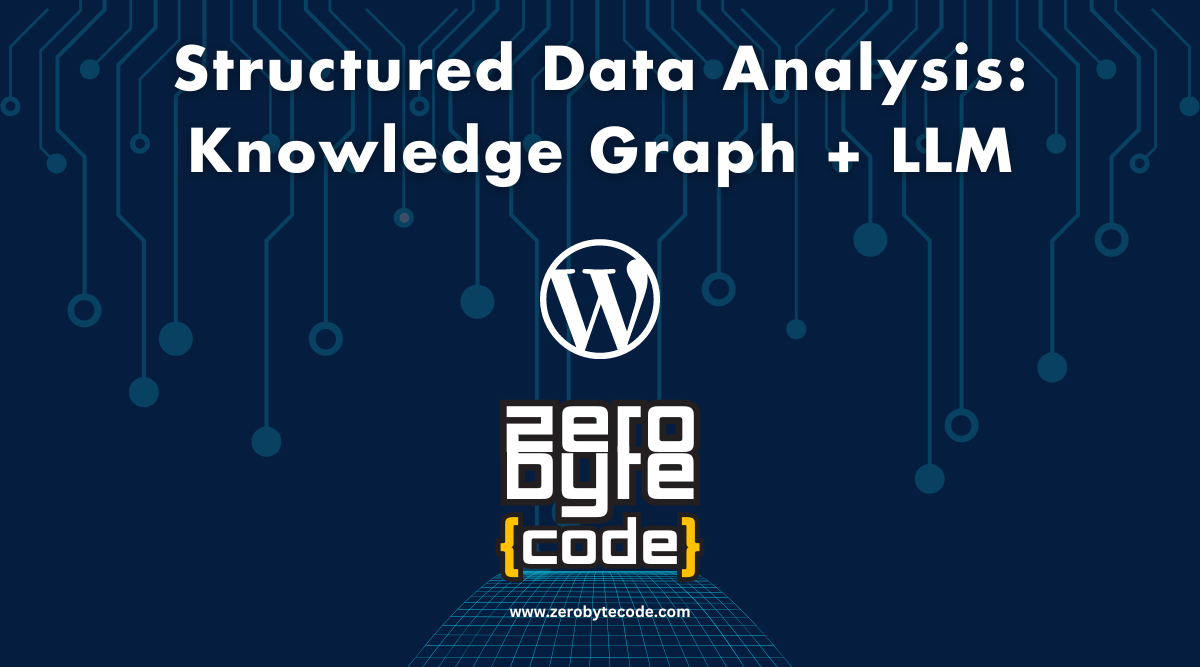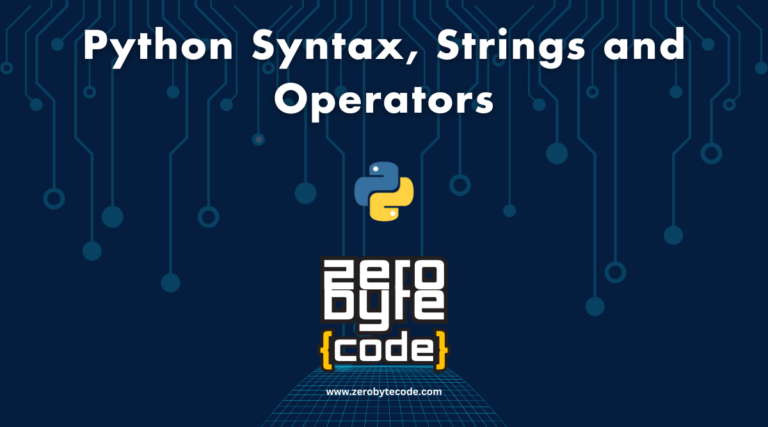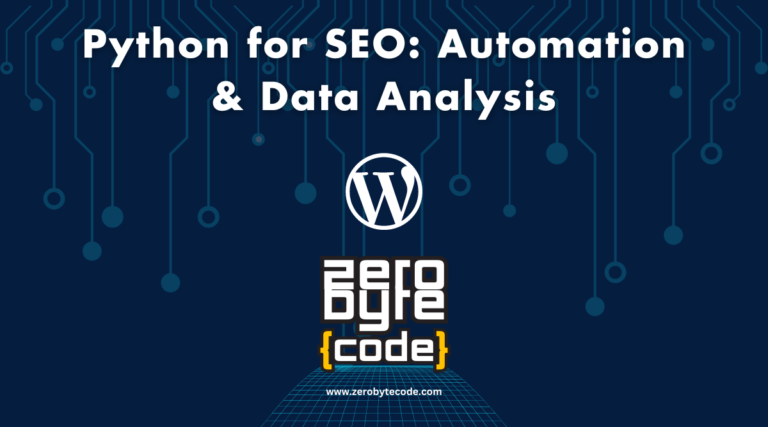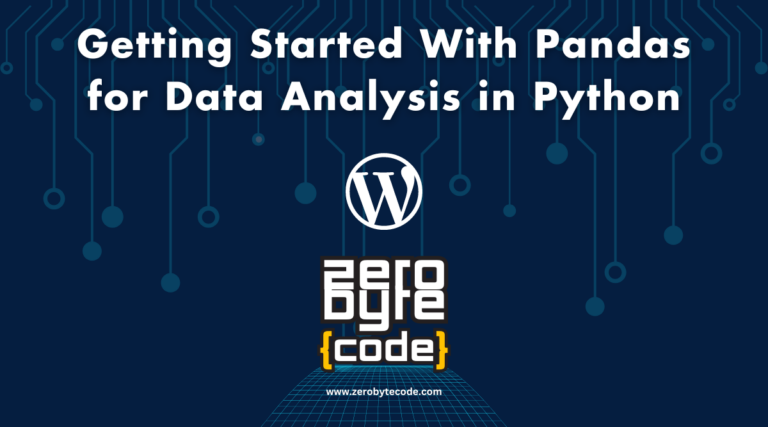Python Structured Data Analysis Using Knowledge Graph + LLM
Structured Data Analysis Using Knowledge Graph + LLM – Structured data analysis using knowledge graphs and large language models (LLMs) is transforming the landscape of data interpretation and decision-making across diverse industries.
- Understanding the Basics of Structured Data Analysis
- Integrating Knowledge Graphs and LLMs for Data Analysis
- Step-by-Step Guide to Implementing Structured Data Analysis
- Tools and Technologies for Effective Implementation
- Best Practices and Advanced Strategies for Maximizing Results
- Future Directions and Emerging Trends in Structured Data Analysis
This approach combines the structured relationships and semantic richness of knowledge graphs with the sophisticated contextual understanding of LLMs, offering unprecedented accuracy and depth in uncovering insights.
As organizations seek to harness these capabilities, understanding the integration process and the tools involved becomes paramount.
Key Takeaways
Hide- Combines structured data with linguistic insights for enhanced data interpretation and analysis.
- Enables nuanced data analysis through context-aware LLMs like GPT and BERT.
- Integrates disparate data sources for comprehensive and accurate market trend predictions.
- Enhances decision-making by uncovering deep patterns and driving innovative insights.
What are the key considerations and steps to effectively implement this innovative methodology? The following sections will explore these critical aspects in detail.
Understanding the Basics of Structured Data Analysis
To effectively understand structured data analysis, it is essential to first define structured data and its significance in data-driven decision-making.
Subsequently, an introduction to knowledge graphs will illustrate how relationships between data points can be systematically represented.
Defining Structured Data: What It Is and Why It Matters
Structured data refers to data that is highly organized and easily searchable within fixed fields, often stored in relational databases.
Its key characteristics include predefined formats and schemas, which distinguish it from unstructured data that lacks a specific structure, such as text documents or multimedia files.
Understanding these differences is essential for leveraging structured data effectively in analytical processes and knowledge graph applications.
Key Characteristics of Structured Data
In the domain of data analysis, structured data stands out for its organization into predefined models and formats, enabling efficient querying and analysis.
Key characteristics include well-defined data types, adherence to schemas, and relational integrity.
This format facilitates rapid access, manipulation, and integration, driving innovation in data-driven decision-making processes and enhancing the reliability of insights derived from analytical models.
How Structured Data Differs from Unstructured Data
While structured data is characterized by its predefined models and schemas, unstructured data lacks such organization, presenting unique challenges and opportunities for data analysis.
Structured data, typically found in relational databases, allows for straightforward querying and analysis.
Conversely, unstructured data, encompassing text, images, and multimedia, requires advanced techniques such as natural language processing and machine learning to extract meaningful insights.
Introduction to Knowledge Graphs
A knowledge graph represents a sophisticated model for structured data analysis, integrating entities, relationships, and attributes into an exhaustive framework.
Understanding its key components and functions—such as nodes, edges, and properties—enables effective data organization and retrieval.
Tracing its historical evolution highlights its pivotal role in modern data analysis, underscoring its relevance and transformative impact on information management and decision-making.
What is a Knowledge Graph? Key Components and Functions
Frequently regarded as a pivotal framework in modern data management, a knowledge graph systematically organizes and interconnects data to facilitate advanced analysis and retrieval.
Key components include:
- Entities: Core data units representing real-world objects.
- Relationships: Connections between entities, illustrating how data points are interrelated.
These elements collectively enhance data comprehension and utility.
Historical Evolution and Relevance in Modern Data Analysis
Understanding the historical evolution of knowledge graphs underscores their growing importance in modern data analysis practices.
Initially rooted in semantic web technologies, knowledge graphs have evolved to integrate sophisticated machine learning algorithms, enhancing their ability to interconnect and contextualize vast datasets.
This evolution has rendered them indispensable for extracting actionable insights, driving innovation, and fostering informed decision-making in today’s data-centric landscape.
Understanding Large Language Models (LLMs)
Understanding Large Language Models (LLMs) like GPT and BERT is essential for structured data analysis as they offer advanced capabilities in natural language understanding and generation.
These models enhance data interpretation by identifying patterns, extracting insights, and generating contextually relevant information from vast datasets.
Overview of LLMs: From GPT to BERT and Beyond
Large Language Models (LLMs) like GPT and BERT have revolutionized the field of structured data analysis by leveraging advanced natural language processing techniques to interpret, generate, and manage vast amounts of textual data.
- GPT: Generative Pre-trained Transformer, excels in generating human-like text.
- BERT: Bidirectional Encoder Representations from Transformers, focuses on understanding context.
- Beyond: Emerging models integrate these capabilities for superior performance.
How LLMs Enhance Data Interpretation and Insight Extraction
By leveraging their advanced natural language processing capabilities, large language models (LLMs) considerably enhance the interpretation of structured data, facilitating the extraction of actionable insights.
LLMs adeptly parse intricate datasets, identifying patterns and correlations that might elude traditional methods.
This enables more nuanced analysis, driving innovative decision-making processes and fostering a deeper understanding of complex data landscapes.
Integrating Knowledge Graphs and LLMs for Data Analysis
Integrating Knowledge Graphs and Large Language Models (LLMs) offers a synergistic approach to enhancing data analysis by leveraging the structured relational insights of knowledge graphs with the advanced linguistic capabilities of LLMs.
This section examines the benefits and challenges of such integration, supported by real-world applications and success stories that demonstrate its practical impact.
Also read: Data Representation in Python
Analyzing these points provides a thorough understanding of how this combined methodology can optimize data-driven decision-making processes.
Synergizing Knowledge Graphs and LLMs: Benefits and Challenges
Integrating Knowledge Graphs and Large Language Models (LLMs) for data analysis offers the distinct advantage of enhancing both the accuracy and relevance of insights derived from structured data.
However, this amalgamation also presents potential challenges, such as ensuring data consistency and managing computational complexity, which require well-defined strategies to address effectively.
Key Advantages: Enhanced Accuracy and Relevance
The integration of knowledge graphs and large language models (LLMs) considerably enhances the accuracy and relevance of data analysis by providing a structured, context-rich framework that facilitates more precise information retrieval and interpretation.
- Contextual Understanding: Enhances comprehension and relevance of data.
- Error Reduction: Minimizes inaccuracies in data processing.
Potential Roadblocks and How to Overcome Them
Despite the significant advantages, combining knowledge graphs and large language models for data analysis presents several challenges that must be meticulously addressed to guarantee peak performance and reliability.
Key roadblocks include data integration complexities, ensuring semantic consistency, and managing computational resource demands.
Overcoming these hurdles involves developing robust data harmonization techniques, implementing advanced semantic validation protocols, and optimizing computational frameworks for scalability.
Case Studies: Real-World Applications and Success Stories
Exploring real-world applications, we examine how integrating knowledge graphs with large language models (LLMs) enhances business intelligence and market analysis by providing deeper insights into consumer behavior and market trends.
In healthcare, this synergy facilitates advanced medical research, leading to breakthroughs in understanding complex disease mechanisms and improving patient outcomes.
These case studies highlight the transformative potential of combining knowledge graphs and LLMs for robust data analysis across various domains.
Business Intelligence and Market Analysis
In leveraging the combined capabilities of Knowledge Graphs and Large Language Models (LLMs), businesses can derive nuanced insights that drive more informed decision-making in market analysis and business intelligence.
- Enhanced Data Connectivity: Seamlessly integrate disparate data sources for thorough analysis.
- Predictive Analytics: Utilize sophisticated models to forecast market trends accurately.
- Customer Behavior Insights: Uncover deep patterns in consumer data to tailor marketing strategies effectively.
Healthcare and Medical Research Insights
Harnessing the combined strengths of Knowledge Graphs and Large Language Models (LLMs), the healthcare sector has witnessed significant advancements in medical research and patient care, evidenced by numerous real-world applications and success stories.
These technologies enable the integration and analysis of vast datasets, uncovering intricate patterns and relationships, thereby enhancing diagnostic accuracy, personalized treatment plans, and accelerating drug discovery processes with unprecedented precision and efficiency.
Step-by-Step Guide to Implementing Structured Data Analysis
Implementing structured data analysis begins with preparing your data, ensuring it is clean and well-organized to facilitate accurate results.
The next step involves building and utilizing knowledge graphs to establish relationships and context among data points.
Preparing Your Data: Essential Steps for Clean and Structured Data
To initiate structured data analysis, it is vital to begin with meticulous data collection practices to guarantee the quality and relevance of the data.
Following this, the data must undergo rigorous cleaning and preprocessing using advanced tools and techniques to eliminate inconsistencies and enhance accuracy.
These foundational steps are essential for achieving reliable and insightful results in knowledge graph applications.
Data Collection: Best Practices for Optimal Results
Establishing a robust data collection framework is critical for guaranteeing the accuracy and reliability of structured data analysis.
Key best practices include:
- Data Source Validation: Guarantee the credibility and relevance of your data sources.
- Consistent Data Logging: Maintain uniform data recording practices for consistency.
These practices lay the foundation for high-quality, structured data analysis.
Cleaning and Preprocessing: Tools and Techniques
A meticulous approach to cleaning and preprocessing is essential for transforming raw data into a structured format suitable for thorough analysis.
Employing advanced tools such as Python’s Pandas library, OpenRefine, and Talend, alongside techniques like data normalization, deduplication, and outlier detection, guarantees data integrity and reliability.
Innovators benefit from a robust foundation, enabling seamless integration with knowledge graphs and Large Language Models (LLMs).
Building and Utilizing Knowledge Graphs
To effectively build and utilize knowledge graphs, one must first understand the various tools and platforms available for their creation, such as Neo4j and RDF.
Following this, seamless integration of these graphs with existing data systems is essential for ensuring interoperability and maximizing analytical capabilities.
This section will provide a methodical guide to these processes, detailing each step for successful implementation.
Creating a Knowledge Graph: Tools and Platforms Explained
Implementing a knowledge graph necessitates the selection of robust tools and platforms that can efficiently handle the complexities of structured data analysis.
Key considerations include:
- Graph Databases: Neo4j, Amazon Neptune, and Microsoft Azure Cosmos DB for storing and querying graph data.
- Ontology Management: Protégé and TopBraid Composer for designing and managing ontologies.
Integrating Knowledge Graphs with Existing Data Systems
Having selected the appropriate tools and platforms for creating a knowledge graph, the next step involves seamlessly integrating these graphs with existing data systems to enhance structured data analysis capabilities.
This integration can be systematically approached by considering key factors such as compatibility, scalability, and data synchronization.
| Step | Action | Consideration |
|---|---|---|
| 1 | Assess Compatibility | System Requirements |
| 2 | Plan Scalability | Future Growth |
| 3 | Guarantee Synchronization | Data Accuracy |
| 4 | Implementation | Monitoring |
Leveraging LLMs for In-Depth Analysis
To effectively leverage Large Language Models (LLMs) for in-depth analysis, one must adhere to best practices in training and fine-tuning these models, ensuring peak performance and accuracy.
Integrating LLMs into existing workflows requires practical tips that focus on seamless implementation, enhancing analytical capabilities.
This section provides a detailed, step-by-step guide to mastering these aspects, facilitating structured data analysis with advanced techniques.
Training and Fine-Tuning LLMs: Best Practices
Consistently achieving ideal performance in structured data analysis involves adhering to best practices for training and fine-tuning large language models (LLMs).
Key strategies include:
- Data Quality: Confirm the dataset is clean, well-labeled, and representative.
- Hyperparameter Tuning: Adjust learning rates, batch sizes, and other parameters for peak performance.
Implementing LLMs in Your Workflow: Practical Tips
Integrating large language models (LLMs) into your workflow for structured data analysis demands a meticulous, step-by-step approach to assure thorough and accurate implementation.
Begin by clearly defining your data requirements and objectives.
Next, guarantee robust data preprocessing to maintain data integrity.
Tools and Technologies for Effective Implementation
To effectively implement structured data analysis using knowledge graphs, it is vital to understand the essential tools and technologies available, such as graph databases, ontology editors, and machine learning frameworks.
Selecting the appropriate tools for your project requires careful consideration of factors including scalability, compatibility, and ease of integration.
This section will provide an extensive overview of these tools and offer insights into making informed decisions for best project outcomes.
Overview of Essential Tools for Knowledge Graphs and LLMs
The effective implementation of knowledge graphs and large language models (LLMs) necessitates the use of specialized software and platforms designed for these purposes.
Key tools for constructing knowledge graphs include Neo4j, GraphDB, and RDF4J, each offering unique capabilities for data modeling and querying.
In parallel, leading LLMs such as GPT-4 and BERT are employed for a variety of applications, ranging from natural language understanding to automated content generation.
Popular Software and Platforms for Building Knowledge Graphs
Modern advancements in data analysis necessitate the use of robust software and platforms for constructing knowledge graphs, which are pivotal for extracting and linking structured information efficiently.
Several leading tools facilitate this process:
- Neo4j: Renowned for its scalable graph database capabilities.
- Ontotext GraphDB: Ideal for semantic graph databases and RDF triples.
Leading Large Language Models and Their Application Scenarios
Harnessing the capabilities of leading Large Language Models (LLMs) such as GPT-4 and BERT revolutionizes the integration and utility of knowledge graphs in various data analysis scenarios.
These models enable sophisticated natural language processing, enhancing data retrieval, semantic search, and relationship extraction.
The synergy between LLMs and knowledge graphs fosters more accurate insights, driving innovation in fields like healthcare, finance, and intelligent customer support.
Selecting the Right Tools for Your Project: Key Considerations
Selecting the right tools for implementing a knowledge graph project necessitates a thorough evaluation of tool capabilities and limitations.
It is essential to align these tool features meticulously with the specific goals and requirements of your project.
This methodical approach guarantees that the chosen technologies not only meet performance expectations but also integrate seamlessly into the existing workflow.
Evaluating Tool Capabilities and Limitations
When evaluating tool capabilities and limitations for implementing a knowledge graph, it is essential to methodically assess factors such as scalability, integration compatibility, and user-friendliness to guarantee alignment with project requirements.
- Scalability: Can the tool handle large, complex datasets?
- Integration Compatibility: Does it seamlessly integrate with existing systems?
- User-Friendliness: Is the interface intuitive for all users?
Aligning Tool Features with Project Goals and Requirements
To guarantee the successful implementation of a knowledge graph, it is critical to meticulously align the features of chosen tools with the specific goals and requirements of the project.
This alignment guarantees ideal functionality and performance.
| Project Goal | Tool Feature Requirement |
|---|---|
| Data Integration | ETL Capabilities |
| Scalability | Distributed Architecture |
| Query Efficiency | Indexing Mechanisms |
| Security | Access Control |
| Analytics | Advanced Visualization |
Best Practices and Advanced Strategies for Maximizing Results
In optimizing knowledge graph applications, effective data management and governance are paramount to ensuring data integrity and usability.
Employing advanced analytical techniques and innovations can further enhance the extraction of actionable insights.
This discussion will focus on strategies that combine rigorous data governance with cutting-edge analytical methodologies to maximize the efficacy of structured data analysis.
Effective Data Management and Governance
Effective data management and governance hinge on maintaining high data quality and integrity through robust strategies and methods.
Compliance with regulatory standards and ethical considerations in data analysis are paramount to ensuring responsible and lawful use of information.
Implementing advanced techniques for data validation, auditing, and monitoring will maximize the reliability and utility of the knowledge graph.
Ensuring Data Quality and Integrity: Strategies and Methods
Consistently guaranteeing data quality and integrity involves implementing robust strategies and methods that are essential for reliable and accurate knowledge graph construction.
- Automated Data Validation: Employ machine learning algorithms to detect anomalies and inconsistencies.
- Data Lineage Tracking: Monitor data origin and transformations to maintain accuracy.
These methodologies enhance the fidelity of structured data analysis.
Compliance and Ethical Considerations in Data Analysis
Guaranteeing compliance and addressing ethical considerations in data analysis necessitates a thorough framework that integrates best practices and advanced governance strategies.
Implementing robust data management and governance protocols is essential.
| Best Practice | Description | Benefit |
|---|---|---|
| Data Minimization | Collect only necessary data | Reduces privacy risks |
| Transparency | Clear communication with stakeholders | Builds trust and accountability |
| Regular Audits | Periodic compliance checks | Guarantees adherence to standards |
| Ethical Guidelines | Establish ethical data usage criteria | Prevents misuse of data |
Advanced Analytical Techniques and Innovations
Incorporating machine learning and AI integrations into knowledge graphs has revolutionized the landscape of predictive analytics and forecasting.
Emerging trends highlight the potential of these technologies to enhance data interpretation and uncover patterns that were previously undetectable.
Leveraging large language models (LLMs) further amplifies this capability, enabling more nuanced and accurate predictive insights.
Machine Learning and AI Integrations: Emerging Trends
The integration of machine learning and AI into knowledge graphs has revolutionized data analysis by enabling more precise, scalable, and insightful interpretations of complex data sets.
Key emerging trends include:
- Hybrid Models: Combining symbolic reasoning with neural networks for enhanced accuracy.
- AutoML: Automated machine learning frameworks to streamline model selection and tuning.
Predictive Analytics and Forecasting Using Knowledge Graphs + LLM
Leveraging knowledge graphs and large language models (LLMs) for predictive analytics and forecasting requires a sophisticated approach that integrates advanced analytical techniques and innovative strategies to yield highly accurate and actionable insights.
Employing methods such as graph embeddings, neural network integration, and temporal analysis guarantees robust predictions.
Additionally, continuous model refinement and real-time data assimilation are pivotal for maintaining relevance and precision in dynamic environments.
Future Directions and Emerging Trends in Structured Data Analysis
As we look ahead, the integration of knowledge graphs in data analysis is set to revolutionize data-driven insights through enhanced semantic relationships and contextual understanding.
Concurrently, advancements in large language models promise to augment the interpretative capabilities of structured data, pushing the boundaries of automated analytics.
This evolving landscape necessitates a closer examination of the synergistic potential between these technologies and their application in various domains.
The Future of Knowledge Graphs in Data Analysis
The future of knowledge graphs in data analysis is poised for significant advancements, marked by potential innovations that enhance their scalability and integration capabilities.
Emerging trends indicate a pivotal role for knowledge graphs in augmenting AI and data science, particularly in areas of natural language processing and predictive analytics.
These developments suggest a transformative impact on how structured data is utilized and interpreted across various industries.
Potential Innovations and Developments on the Horizon
Future advancements in knowledge graph technology are poised to revolutionize structured data analysis by enhancing the depth and accuracy of data interconnections.
Key innovations include:
- Dynamic schema evolution for real-time updates and adaptability.
- Enhanced integration with natural language processing for richer semantic understanding.
These developments promise to greatly elevate the capabilities and applications of knowledge graphs in data analysis.
The Role of Knowledge Graphs in AI and Data Science
Knowledge graphs are increasingly pivotal in AI and data science, driving advancements by structuring and contextualizing data for enhanced machine learning outcomes.
Their role extends to improving data interoperability, enabling more sophisticated natural language processing, and fostering seamless integration of disparate data sources.
Future trends indicate a surge in hybrid models combining knowledge graphs with deep learning, enhancing predictive analytics and decision-making processes.
Advancements in Large Language Models: What’s Next?
The rapid advancements in large language models (LLMs) promise significant improvements in their ability to process and analyze structured data, potentially enhancing accuracy and efficiency.
These improvements are expected to impact various domains, including natural language understanding and automated data integration.
As LLMs evolve, their integration with knowledge graphs could redefine approaches to structured data analysis, offering more intelligent and context-aware systems.
Future Prospects and Expected Improvements in LLMs
Anticipating continued advancements in Large Language Models (LLMs), the integration of structured data analysis with these models is poised to revolutionize data-driven decision-making processes.
Key expected improvements include:
- Enhanced contextual understanding: More accurate interpretation of complex data relationships.
- Scalability: Greater efficiency in handling vast datasets.
These advancements promise substantial progress in data analysis capabilities.
The Impact of LLM Advancements on Structured Data Analysis
Advancements in large language models (LLMs) are set to greatly influence structured data analysis by enhancing the precision and depth of data interpretation. These advancements promise to refine the following aspects:
| Aspect | Current State | Future Potential |
|---|---|---|
| Data Accuracy | Moderate | High |
| Interpretation | Basic | Advanced |
| Automation | Limited | Extensive |
| Integration | Fragmented | Seamless |







